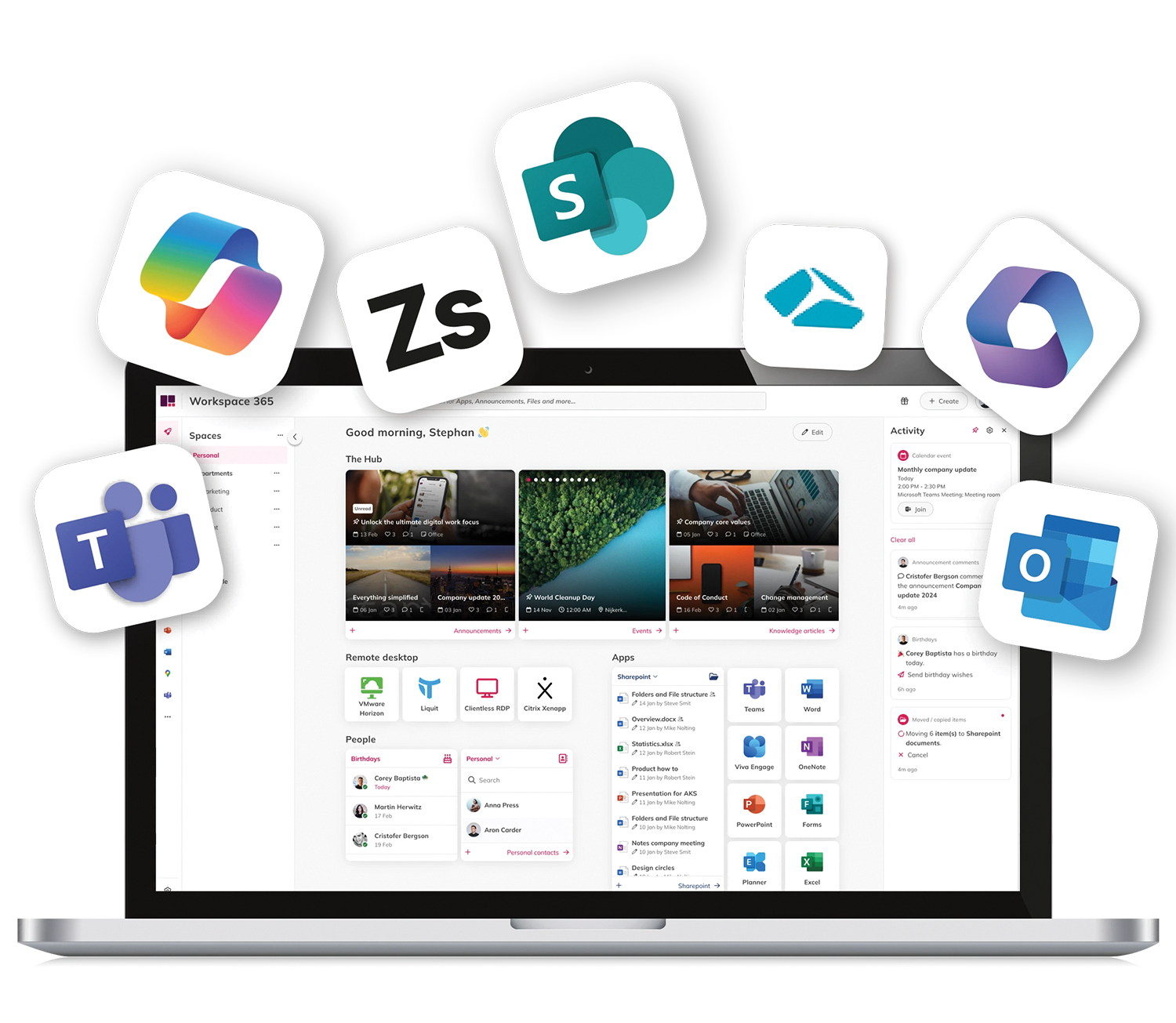Are you planning to switch to a new digital workplace? A big part of the ultimate success depends on the composition of the project team and the collaboration between the project members. How do you put together the ideal digital workplace project team? What are the key roles and responsibilities? What are the key focus points for the project team? Find out more about the steps to take when setting up a project team.
The importance of a project team
Rolling out a (new) digital workplace is an important strategic initiative for an organisation. A good digital workplace simplifies communication and collaboration. In addition, employees can not only access all information, documents and data, but can also directly complete all kinds of tasks. Regardless of where they are, when and with which device they want to work.
A digital workplace should therefore be exactly tailored to the organisation. It must meet all the wishes and requirements of the organisation and, in addition, there must be a focus on the overall user experience. Only a carefully composed and optimally functioning project team can achieve this.
Tasks of the project team
The project team is responsible for selecting and managing the digital workplace as well as ensuring its adoption. The project team should be involved in all phases, from research and planning to change management, launch and user adoption.
Success factors and best practices
How do you select the perfect project team? There are certain success factors and best practices that every organisation should consider. A common mistake is that companies rely on IT alone. Everyone in the organisation is going to use the workplace, so it is important that the project includes every department. Are end-users not sufficiently involved in checking what is really needed? Then you run the risk of certain essential functionalities being overlooked.
The project team should therefore be cross-functional in nature. Often, though, IT, HR and communication have a leading role. IT is responsible for implementing and managing the workplace. Along the way, IT should map out all relevant functional and technical issues, such as hosting, software development and integrations.
During the digital transformation process, HR and Communication are responsible for promoting the project by continuously publishing enthusiastic and informative content for the various communities.
HR has a direct interest: a good digital workplace delivers a strong digital employee experience. The role of communication is also linked to the intranet, which plays an important role within the digital workplace.
Roles within the project team
The following roles are common in digital workspace project teams.
Project manager
The project manager brings everyone together, manages budgets, coordinates meetings and ensures that people complete their tasks. He or she also identifies the needs of end users and helps both choose the right solution and manage implementation. Tasks also include developing policies and guidelines, reporting to management and managing budgets and resources.
Project sponsor
Although the project sponsor is usually less involved in the project team, he or she is at least as important as the other team members. This is often someone with more seniority who has a steering role within the project and represents the project in relation to other senior stakeholders.
Business analyst
Business analysts are often involved in technology projects. Among other things, they play an important role in gathering all requirements and user research.
Stakeholders
Different stakeholders may belong to the project team. The RACI matrix (responsible, accountable, consulted, informed) can be used to determine the level of stakeholder involvement in the project.
Management
Often, someone from management is also a member, such as the CIO, COO or possibly even the CEO. They often have a good overview of budgets and are directly involved in the digital workplace governance model.
External parties
It is not unusual for representatives of external parties to be part of the project team, such as an employee of the digital workplace vendor.
Roles outside the core team
There may also be various roles outside the actual core team, such as:
- Members of a cross-functional management group who, among other things, set the project's vision, ensure there is sufficient cash and monitor progress.
- Experts in communication and change management.
- Specialists.
- Representatives of end-user groups, who provide feedback and insights and test the solution for usability, for example.
- Super users, or key players within the organisation who play an important role in adoption and are therefore valuable for testing and feedback.
Qualities project team members should have
Project team members do not have to be supermen, but it is an advantage if they have certain qualities. A new digital workplace is a big project with many different aspects and stakeholders. Project team members must therefore be able to stand out in planning, collaborating, communicating and avoiding conflicts. Only if everyone is on board, an environment of trust and transparency is created and the project is seen as a joint effort, a digital workplace can ultimately be rolled out that meets all needs and requirements.
Creating an ideal project team: best practices
Many digital workplace projects were created through trial and error. Fortunately, a lot of best practices have emerged from this, which you can apply to build the ideal project team. Such as:
1. Business and IT hand in hand
Right from the start, business and IT should be well represented in the project team and work closely together. Also carefully look at the balance: is business or IT not overrepresented in the team?
2. Distinguish between the core team and the wider team
In addition to the core team, there is a wider team including members of a cross-functional steering committee, communication experts and specialists. Not only is the composition important, the tasks and responsibilities of both teams should also be carefully considered. If it turns out that certain tasks and responsibilities are not adequately performed by the core team, the wider team can pick them up.
3. Let experience, skills and specialisms be leading
The digital workplace project stands or falls with the experience, skills and specialisms of the (core) project team members. So don't just check whether all departments, functions and branches are represented, but also examine what skills, experiences and specialisms the project team needs to achieve the best result.
4. Diversity leads to quality
A diverse project team often produces better results. Do members have many different backgrounds, specialisms, perspectives and experiences? Then they learn from each other, have more knowledge, can innovate better and are more solution-oriented.
5. Check availability
It may sound like an unnecessary detail, but check in advance that the people you want in your project group are actually available throughout the project.
Key focus points for the project team
Is the project team up and running? Great! Now the real work begins. It is important for every workplace team to keep the following points in mind.
Scope
The first step should always be defining the scope. Defining the why, what and how of the project creates a holistic picture. What do we all need to do to achieve our goals?
Roadmap
If you establish a roadmap, then all departments can work towards the set goals in a coordinated way. To do this, you need to ask a number of questions to each department involved. The most important one: how will you use technology to improve employees' digital experiences, productivity and creativity?
Inform, inform, inform
User adoption, as in fact with all technology projects, is one of the most important keys to eventual success. The project team should lead by example by informing employees about the project through various channels.
Training employees
Training employees also helps increase adoption. Both existing and new employees should receive specific digital workplace training. This should include an explanation of why this technology has been chosen and what the benefits are for both employees and the organisation. Plenty of documentation should also be available.
Governance
Before the digital workplace goes live, various governance aspects need to be carefully considered. Through things like information monitoring, policy creation and crisis management rigging, the digital workplace delivers maximum connectivity and collaboration opportunities, while minimising risks.
The result of a good project team: the best workplace
An adaptive digital workplace such as Workspace 365 offers all applications, documents, information, data and tasks in one environment. Instead of having to search for the right information yourself among all the apps, documents and data, Workspace 365 evolves into a self-navigating digital workplace that guides all your employees through the day. With all the information they need, from any device and wherever your employees are.
Sure, it requires a certain investment in terms of time and resources to put together the ideal project group and get it to do its job as thoroughly as possible. But later on, it will pay off. In higher productivity, but also in future proof technology experiences, happier employees, less absenteeism and less staff turnover. Finally, the social functionalities create more engagement and improved connections between colleagues.






